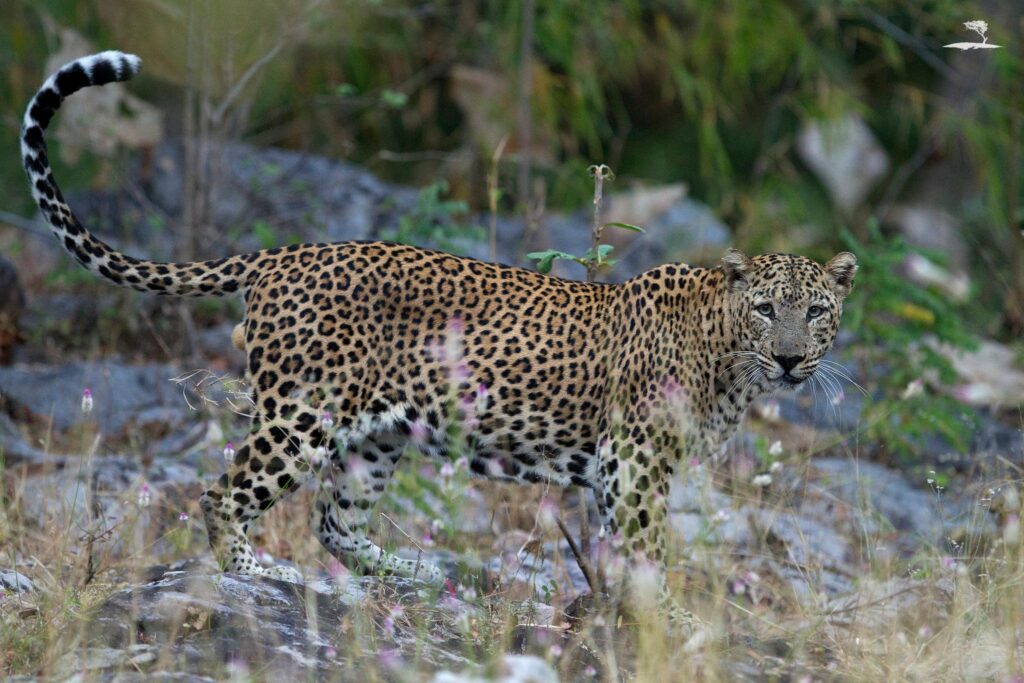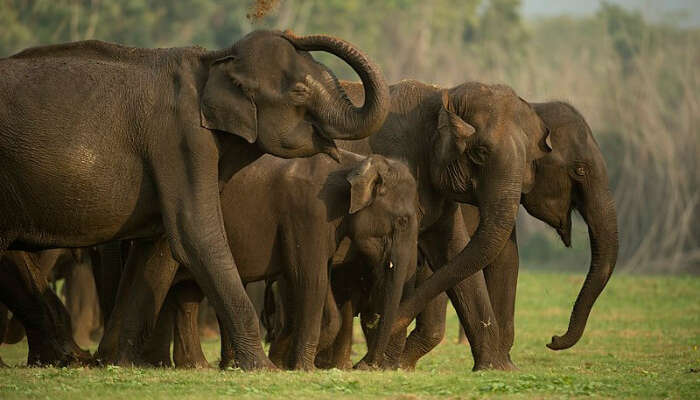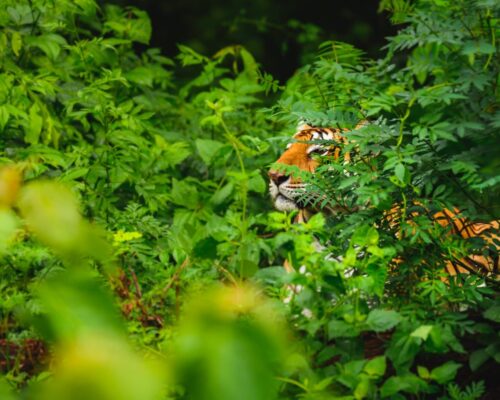Kabini Wildlife Sanctuary has a long history of conservation.
Kabini Forest, located on the banks of the Kabini River in Karpur Forest Area, is one of Karnataka’s most beautiful forests. The Kabini Forests in Karnataka are home to a diverse range of flora and animals and are nestled among the greenery of the Western Ghats. Kabini Forests is truly unique, with everything from antelopes and leopards to a playful group of elephants.
- Get to Kabini Wildlife Sanctuary.
- The Kabini Wildlife Sanctuary is located in the Nagar hole National Park on the banks of the Kabini River, a branch of the Cauvery River.
- Mysore Airport is located 80 kilometres away.
- Mysore, 80 kilometres away, is the closest railhead.
- Conservation History
Kabini Forests, located far from the fast-paced life of the city, is the ideal tranquil refuge for travellers. Kabini Forest in Karnataka is a haven for a diverse range of plant and animal life, nestled within luscious acres of greenery and deep forests. The Kabini Forests, a perfect habitat for birds and animals, are every nature lover’s dream location.
Kabini Wildlife Sanctuary‘s conservation history extends back a few decades, when this forest was the hunting grounds of the Maharaja of Mysore. After a few years, this property was developed into the Kabini Wildlife Sanctuary, which is home to leopards, gaurs, antelope, crocodiles, tigers, cobras, and pythons. Aside from that, there are a variety of birds to see, including osprey, brown-headed fishing eagles, racket-tailed drongos, golden-backed woodpeckers, storks, and peafowl. Resort in Kabini could give you a comfortable stay while you explore the Kabini wild life sanctuary.
The history of Kabini Nature Reserve is highly interesting, as are the species found in this Karnataka wildlife sanctuary.
Kabini Mammals
Although big cats and elephants are the main attractions of Kabini’s fauna, the dense forests also house a diverse range of animals such as Gaurs, wild boars, barking deer, dholes, deer, sloth bears, monkeys, mongoose, pangolins, and many more mammals. Continue reading to learn more about these magnificent creatures of the natural world!
Kabini Tigers

Tigers are apex predators that have been thriving in Kabini’s jungles. They maintain a healthy predator-prey ratio in the forest by remaining at the top of the food chain.
Tigers are a territorial species. Because of the high tiger density, aggressive territorial clashes have occurred in Kabini’s wildlands. They require extensive contiguous tracts of habitat that support their prey requirements and offspring rearing. Tiger cubs stay with their mother for roughly two decades before it became autonomous and creating their own territories.
These powerful animals’ athleticism can be seen when they leap and stride through the deep thickets of Kabini. Tigers have been recorded leaping up to 10m. They are also superb swimmers, and may often be observed swimming in and drinking from waterholes in the Kabini forest throughout the summer. Spotting these beautiful huge cats in Kabini, whether royally walking around or simply lounging majestically, has already sent chills down people’s spines from time immemorial!
Nagar hole National Park has produced outstanding outcomes as a result of its conservation initiatives. Needless to say, the tiger population in Kabini has increased significantly in recent years. Tiger encounters in Kabini have been more frequent in recent years. Take a vacation and head off to the Kabini Wildlife Sanctuary, you can have a comfortable stay at a resort in Kabini.
Kabini Leopards

Leopards are opportunistic hunters that can adapt to a variety of habitats, including rainforests and dry regions. They can also be found in grasslands and mountainous areas. Leopards’ fur aids in ideal camouflage.
Leopards enjoy a safe habitat in Kabini. A safari in Kabini is considered to be unforgettable because of the sighting of a leopard on a tree. They are adept tree climbers and can frequently be found perched atop tall trees.
In recent years, the most notable sighting in Kabini has been of a melanistic leopard, the Black Panther. He is popularly known as Blackie or the BP. Blackie is well-known for his bravery. Unlike the other leopards, his melanistic fur coat makes it difficult for him to hide himself in the forests, which hampered his hunting in his early days.
But Blackie persevered and went on to conquer a section of the forest that had previously belonged to another fearsome leopard. He’s not afraid of safari vehicles, and he’s regularly observed staring at them the way a monarch looks at his subjects!
Elephants in Kabini’s vicinity

Elephants are herbivores and the largest terrestrial mammals. These gentle giants are recognised for their great memory and have a significant impact on their surroundings. Elephants are fantastic seed dispersers. They consume and expel seeds, some of which germinate. Other creatures, such as monkeys and dung beetles, feed on their dung. They make water holes that other animals use when digging for water during a drought. African bush elephant, African forest elephant, and Asian elephant are the three most well-known elephant species.
Beware! The elephant’s well-known nickname “the gentle giants” might easily be mistaken as them being peaceful and tranquil. They are one of the most violent creatures in the wild when their calves are threatened or their territory are violated!
Kabini boasts one of the world’s biggest densities of Asiatic elephants. It is one of the few sites in the world where huge tuskers can graze freely. Elephant herds can be observed drinking from the backwater and graze on its banks during the summertime.
Kabini and Nagarahole have a plethora of gaurs.
Kabini is home to another herculean species capable of repelling the apex predator- the muscular Gaurs! They are the world’s largest known wild cattle. Their natural habitats are damp deciduous forests and evergreen or semi-evergreen forests.
Kabini has a healthy gaur population. The males are extremely muscular and weigh between 1000 and 1500 kgs, while the females weigh between 700 and 1000 kgs. Gaurs are the most powerful and heaviest kind of wild cattle. Tigers occasionally prey on them.
There have been numerous reports of tigers being chased away by gaurs. Such is the ferocity of this ferocious beast!
Dholes (wild dogs) in Kabini, Nagarahole

Dholes, commonly known as Asiatic wild dogs or Indian wild dogs, are gregarious creatures. Their diminutive and charming appearance should not be mistaken for amicability. They are excellent hunters who can take down prey much larger than themselves since they live and hunt in groups. They dwell in huge clans of about 12 people. Resort in Kabini are very good.
During a hunt, their strategies and teamwork are significant. One or several dholes take over the pursuit of the prey as the remainder of the pack follows at a slower speed, taking over after the group fatigued. Dholes frequently chase their prey into areas of water to obstruct the intended animal’s movement.
Spotted Deer
The spotted deer, often known as the chital, is a herbivorous species native to the Indian subcontinent. Their shiny eyes and acute ears are continuously on the lookout for potential hazards! In Kabini, near the backwaters, they are preyed upon by tiger, leopard, dholes, and crocodile. Males are bigger and also have antlers than female.
Kabini is teeming with spotted deer. They are frequently seen at the national park’s entrance.
Sambar Deer is a type of deer native to the Indian subcontinent and other regions of Asia. It is light brown to dark brown with a greyish or yellowish tinge.
They eat grass, leaves, fruits, shrubs, and trees. Their weight ranges from 100 to 350 kg. Tigers, leopards, and dholes gorge themselves on these muscular beasts. A stay at the resort in Kabini would definitely help you spot some of this deer family.
Macaques are monkeys (Monkeys)
The two most common monkey species in Kabini are bonnet macaques and grey langurs. Bonnet macaques, a kind of monkey abundant in metropolitan areas of Southern India, are also common in Kabini’s woods. Fruits, nuts, seeds, flowers, and various invertebrates are among their favourite foods.
When they spot a predator, grey langurs in Kabini are recognised for their notorious alarm calls, which they give out to other creatures like as deer, sambars, and so on. Many predators have had to go hungry as a result of this! Leaves, leaf buds, fruits, shoots, roots, grass, mosses, and lichens are mostly herbivorous. They also eat non-plant debris such as spider webs, insect larvae, and termite mounds. Tigers, leopards, and dholes prey on them in Kabini.
The Malabar Giant Squirrel
The Malabar giant squirrel is a tree squirrel species that is large, fluffy, and colourful, with a head and body length of 25-50cm and a tail that is about the same or slightly greater in length. It weights between 1.5 and 2 kg. It inhabits tropical deciduous, semi-deciduous, and moist evergreen forests and woods.
Malabar gigantic squirrels live in towering trees and may jump up to 6 metres between them. They rarely leave trees and require lofty trees with plenty of limbs to build their nests. Birds of prey such as owls and leopards are their primary predators.
Kabini’s Birds
Kabini is home to a wide diversity of birds. Some of the most common birds seen in Kabini forest include peafowls, Indian paradise flycatchers, Ospreys, Oriental darters, and eagles.
Peafowls are well-known for the male’s flamboyant feather display. They eat snakes, rodents, and lizards. Adult peafowls normally flee into trees when confronted by a predator, though dholes, leopards, and tigers can sometimes ambush them. Peacocks exhibiting their trains to attract peahens are regularly seen in Kabini’s woodlands.
The Indian paradise flycatchers enchant us with their magnificent flight despite their appearance, which appears to be right out of a fairy tale book. They are indigenous to India, Central Asia, and Myanmar. They eat insects that they catch in the air using their amazing manoeuvres. Male Indian Paradise flycatchers have lengthened middle tail feathers, which creates a wonderful spectacle when they fly!
The Osprey is a huge fish-eating bird of prey. Their wingspan is 50 to 71 inches and their length ranges from 20 to 26 inches. Ospreys have the ability to detect underwater objects from the air. They dive feet first into the water after seeing the prey from a height of 10 to 40 metres. Our current camera bodies aren’t the only ones that can latch on to their targets!
A waterbird with a high, slender neck as well as a straighter, sharp beak, the eastern darter It hunts for fish by spearing it while submerged. It later pulls the fish out of the water, throws and juggles it, then swallows it headfirst. Oriental darters have wettable feathers and are frequently seen resting on a rock or branch with their wings extended to dry.
Two of the main eagle types in Kabini are the Painted serpent eagle and the Able to be changed hawk-eagle. Bird-watchers would love to stay at the resort in Kabini and take stroll to see lots of these birds.
Crested serpent eagles are named after their preferred prey, snakes. They also prey on lizards.They have dark brown skin, rounded wingspan, and a shorter tail.
The changeable hawk-eagle is a large but thin eagle. It feeds on birds, reptiles, and certain vertebrates. It can be found sitting atop solitary trees in the Kabini woodland. White-bellied Woodpeckers, White-throated Kingfishers, Pied Kingfishers, Oriental Honey Buzzards, Forest-eagle Owls, Owlets, Indian and King Vultures, Osprey, Darters, Shanks, Racket-tailed Drongos, a variety of Flamebacks, Malabar Pied Hornbills and Grey Hornbills, Grey-headed Fish Eagles, Indian Pittas, and other visits’
Kabini Wildlife – Summary
With this variety of species, Kabini is certainly one of the top National Parks in the country for a safari. It is well-known for good sightings all year, regardless of season. Unlike national parks such as Bandhavgarh and Ranthambore, which are only open during certain seasons, Kabini is open all year. Read our blog When is the best time to visit Kabini to discover more about the best time to visit Kabini. Stay for a comfortable vacation at the resort in Kabini to get the best of this amazing place.
Spotting animals in the outdoors, in their natural habitat, either walking freely or being extremely alert, gives us an indescribable emotion. It is a synthesis of two radically opposed mental states. A sensation of tranquilly that pervades the woodland will undoubtedly envelop us in its silence. It’s mixed with an adrenaline surge brought on by the suspense of not knowing what’s going to happen next.
This is what makes safari trips so remarkable. Our present lifestyles, which are filled with tension and worry, have caused us to seek out many such stress-relieving choices. What better way to de-stress than to travel into the forest and feel rejuvenated?



